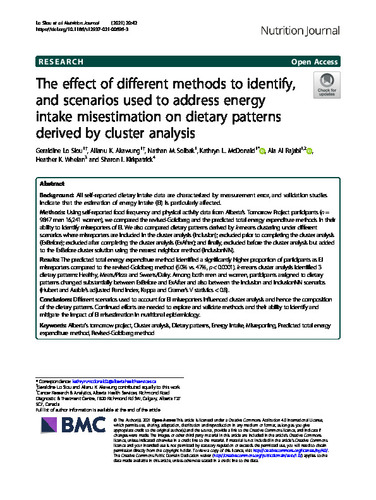| dc.contributor.author | Lo Siou, Geraldine | |
| dc.contributor.author | Akawung, Alianu K. | |
| dc.contributor.author | Solbak, Nathan M. | |
| dc.contributor.author | McDonald, Kathryn L. | |
| dc.contributor.author | Al Rajabi, Ala | |
| dc.contributor.author | Whelan, Heather K. | |
| dc.contributor.author | Kirkpatrick, Sharon I. | |
| dc.date.accessioned | 2021-09-21 13:18:12 (GMT) | |
| dc.date.available | 2021-09-21 13:18:12 (GMT) | |
| dc.date.issued | 2021-05-08 | |
| dc.identifier.uri | https://doi.org/10.1186/s12937-021-00696-3 | |
| dc.identifier.uri | http://hdl.handle.net/10012/17437 | |
| dc.description.abstract | Background: All self-reported dietary intake data are characterized by measurement error, and validation studies
indicate that the estimation of energy intake (EI) is particularly affected.
Methods: Using self-reported food frequency and physical activity data from Alberta’s Tomorrow Project participants (n =
9847 men 16,241 women), we compared the revised-Goldberg and the predicted total energy expenditure methods in their
ability to identify misreporters of EI. We also compared dietary patterns derived by k-means clustering under different
scenarios where misreporters are included in the cluster analysis (Inclusion); excluded prior to completing the cluster analysis
(ExBefore); excluded after completing the cluster analysis (ExAfter); and finally, excluded before the cluster analysis but added
to the ExBefore cluster solution using the nearest neighbor method (InclusionNN).
Results: The predicted total energy expenditure method identified a significantly higher proportion of participants as EI
misreporters compared to the revised-Goldberg method (50% vs. 47%, p < 0.0001). k-means cluster analysis identified 3
dietary patterns: Healthy, Meats/Pizza and Sweets/Dairy. Among both men and women, participants assigned to dietary
patterns changed substantially between ExBefore and ExAfter and also between the Inclusion and InclusionNN scenarios
(Hubert and Arabie’s adjusted Rand Index, Kappa and Cramer’s V statistics < 0.8).
Conclusions: Different scenarios used to account for EI misreporters influenced cluster analysis and hence the composition
of the dietary patterns. Continued efforts are needed to explore and validate methods and their ability to identify and
mitigate the impact of EI misestimation in nutritional epidemiology. | en |
| dc.description.sponsorship | Funder 1, Alberta’s Tomorrow Project is funded by the Alberta Cancer Foundation, the Canadian Partnership Against Cancer || Funder 2, the Alberta Cancer Prevention Legacy Fund (administered by the Government of Alberta) || Funder 3, the University of Toronto || Funder 4, substantial in-kind funding from Alberta Health Services. Although funding has been provided by several organizations, the analyses and interpretation of the data presented in this paper are those of the authors alone. | en |
| dc.language.iso | en | en |
| dc.publisher | BioMed Central | en |
| dc.relation.ispartofseries | Nutrition Journal; | |
| dc.rights | Attribution-NonCommercial-NoDerivatives 4.0 International | * |
| dc.rights.uri | http://creativecommons.org/licenses/by-nc-nd/4.0/ | * |
| dc.subject | Alberta’s tomorrow project | en |
| dc.subject | Cluster analysis | en |
| dc.subject | Dietary patterns | en |
| dc.subject | Energy intake | en |
| dc.subject | Misreporting | en |
| dc.subject | Predicted total energy expenditure method | en |
| dc.subject | Revised-Goldberg method | en |
| dc.title | The effect of different methods to identify, and scenarios used to address energy intake misestimation on dietary patterns derived by cluster analysis | en |
| dc.type | Article | en |
| dcterms.bibliographicCitation | Lo Siou, G., Akawung, A. K., Solbak, N. M., McDonald, K. L., Al Rajabi, A., Whelan, H. K., & Kirkpatrick, S. I. (2021). The effect of different methods to identify, and scenarios used to address energy intake misestimation on dietary patterns derived by cluster analysis. Nutrition Journal, 20(1), 42. https://doi.org/10.1186/s12937-021-00696-3 | en |
| uws.contributor.affiliation1 | Faculty of Applied Health Sciences | en |
| uws.contributor.affiliation2 | Public Health and Health Systems (School of) | en |
| uws.typeOfResource | Text | en |
| uws.peerReviewStatus | Reviewed | en |
| uws.scholarLevel | Faculty | en |


